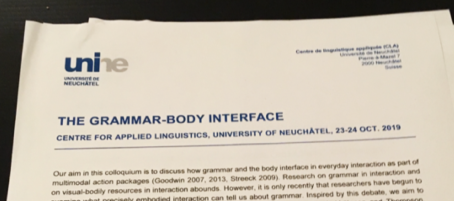A recent meeting in Neuchâtel will be of much interest to ROLSI.net blog readers – the reciprocal connection between grammatical abstractions and their embodied realities is at the centre of theoretical debates in interactional linguistics. I’m delighted that a group of energetic young scholars from the Center for Applied Linguistics, University of Neuchâtel have sent in this lively report of proceedings.
Authors: (in alphabetical order): Sophia Fiedler, Kenan Hochuli, Loanne Janin, Adam Jones, Klara Skogmyr Marian, Ioana-Maria Stoenica
Grammar and the body
Since Charles Goodwin’s (1979/1981) famous multimodal analysis of ‘I gave up smoking cigarettes one week ago today actually’ a lot has happened in the fields of CA and interactional linguistics. The currently booming interest in the interface between grammar and multimodal resources has probably escaped few.

The two-day colloquium ‘The grammar-body interface’, held at the University of Neuchâtel, Switzerland, aimed at furthering our understanding of how grammar and the body intersect in everyday interaction. The colloquium brought together ten European scholars within CA and interactional linguistics who are all working with different aspects of these issues. Present were also the authors of this report: the local PhD students and postdocs in the organizing team.
From head to toe
Taking grammar-in-interaction as a starting point, the program offered a scientific journey throughout the whole body, stretching from top to toe. Jakob Steensig talked about headshakes and grammatical matched polarity, while Peter Auer’s and Simona Pekarek Doehler’s respective presentations both addressed the role of gaze in multimodal constructions, or ‘action packages’. Melisa Stevanovic analyzed distinct embodied conduct, including shifts in body posture, associated with the use of a specific discourse particle in decision-making sequences, while Søren Eskildsen documented longitudinal change in hand gestures used with object-transfer constructions in English as a second language. A number of presentations also focused on larger body movements: Anja Stukenbrock’s and Leelo Keevallik’s respective presentations involved instructions and bodily repositioning in self-defense and pilates classes, while Elwys De Stefani’s and Lorenza Mondada’s studies focused on bodily reconfigurations in guided tours.

Melisa Stevanovic in the house
Some of us PhD and postdoc participants also presented our work-in-progress research on nodding and syntax in collaborative turns (Virginia Calabria), French and German constructions of thinking out loud (Sophia Fiedler), disagreements and concessions in laboratory interactions (Adam Jones), verbally incomplete negative assessments (Klara Skogmyr Marian), and because-clauses in French and Romanian (Ioana-Maria Stoenica). We greatly benefited from the more experienced researchers’ feedback.

Kenan Hochuli, Loanne Janin, Søren Eskildsen and Jakob Steensig listening attentively
In total, 10 languages were represented in the analyzed data: Danish, English, Estonian, Finnish, French, German, Hebrew, Italian, Mandarin, and Romanian. To our knowledge, Ioana-Maria Stoenica’s presentation on Romanian was the first interactional linguistic study on this language (!). Some cross-linguistic issues were discussed, for example the language-specificity of headshaking.
Mondada-inspired consumption
Of course, also the stomach and taste buds got to participate in the grammar-body journey: during wine-tasting at the city wine cellar we could put into practice Lorenza Mondada’s multimodal analysis of tasting-sequences that came up several times throughout the (more scientific part of) the colloquium and over a three-course dinner at the ancient Hôtel DuPeyrou we had a chance to introduce the foreign guests to some Swiss specialties and discuss our research in an informal setting.

Adam Jones, Sophia Fiedler, Elwys De Stefani, Leelo Keevallik and Melisa Stevanovic discussing over dinner
Some highlights and reflections for the future:
- The participants used many different terms to refer to assemblies of talk, embodied conduct, and features of prosody, such as multimodal Gestalts, multimodal action packages, grammar-body packages, gesture-talk connections. What is the difference between these different concepts?
- One issue raised during the colloquium was how collection-based research on complex assemblies of multimodal conduct may be done. To us, this is definitely a concern that deserves more attention in the future. How many different multimodal resources can we simultaneously account for in our collection-based analyses? How do we deal with the distinct temporalities of different resources? Where does a multimodal package begin and end?
- Several presentations showed the emergence and change in multimodal packages over time, and we discussed the context-sensitivity of this change. What is routinized? What disappears?
Finally, we want to thank all participants for attending this event and for the ‘food for thought’ they gave us. We are excited to continue the discussion about grammar and the body!
